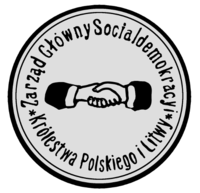Social Democracy of the Kingdom of Poland and Lithuania
Social Democracy of the Kingdom of Poland and Lithuania Socjaldemokracja Królestwa Polskiego i Litwy | |
|---|---|
 | |
| Founded | 1893 (SDKP), 1899 (SDKPiL) |
| Dissolved | 1918 |
| Merged into | Communist Party of Poland |
| Membership | 40,000 (1906) |
| Ideology | Socialism Marxism |
| Political position | Far-left |
| International affiliation | Second International |
The Social Democracy of the Kingdom of Poland and Lithuania (
Leading members
The leading cadre of the SDKPiL were a famous group, many of whom would play a role in the
History
1893: Formation
The party was founded in 1893 based on an
1899: Merger with the Union of Workers in Lithuania
Conceived as the geographical representative party of the workers, rather than national, the SDKP was to fuse with the Union of Workers in Lithuania in 1899 as a result of the work carried out by
1903:The split between Bolsheviks and Mensheviks
Consistent with its self-conception as a geographic unit of an All-Russian Social Democratic party, the SDKPiL attended the
1905: War and Revolution
The
Downturn and split
The period after the revolution was one of retreat for the left and the SDKPiL was to split into two factions as a result. Always closely connected to the RSDLP the Polish party's problems were intricately interwoven with those of the Russian Party. Attending the
World War I: New unity in opposition to war
Despite divisions in its ranks the entire party adopted an internationalist position with the onset of World War I in 1914. The Warsaw Committee of the SDKPiL called a conference of all revolutionary factions for August 2 at which both the Warsaw Committee and Central Committee were joined by the PPS Lewica (Left) and the Bund. The conference issued an unequivocal denunciation of imperialist war and called for the workers to take state power. Despite this attempts to coordinate the different parties came to nothing. But as the war continued both social democratic factions joined the Zimmerwald movement with the Warsaw Committee becoming particularly close to the Bolsheviks. The growing clarification of right and left internationally would enable the two factions of the party to reunify at a congress held on November 4, 1916, a new Central Committee was elected and the party pledged support to the Zimmerwald movement.
End of the party
The
See also
References
- ^ Roman Dmowski, Polish politics and the rebuilding of the state. A foreword to the present edition and a commentary was provided by Tomasz Wituch, vol. I, Warsaw 1988, p. 99.
- ^ W.I Lenin. Lenin on Poland and the Polish workers' movement , Warsaw 1954.
- ^ Robert Blobaum: Feliks Dzierzynsky and the SDKPiL: A study of the origins of Polish Communism, page 148
- ^ "Social Democracy of the Kingdom of Poland and Lithuania. (Russian)".
